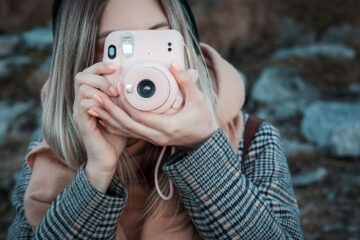Autumn color season is one of the most eagerly anticipated times of the year for restless nature photographers. And since these photos aren’t going to just take themselves, here are 5 essential tips to help you make the most of the autumn color season.
A polarizing filter removes glare from almost any non-metallic surface, which includes autumn leaves. Leaves have a waxy coating and they produce glare when viewed from certain angles. A polarizing filter makes fall color look more colorful and saturated but in reality, it’s only allowing you to see the color that’s already there. Wet leaves create even more glare so during rainy conditions, a polarizing filter is nearly essential.
When working near water, a polarizing filter will also remove glare and refections from the water’s surface and surounding west rocks. It will cut glare from water vapor and particulates in the air as well, making blue skies darker and richer in color. The direction of maximum polarization occurs at 90-degree angles from the sun, while no polarization occurs when shooting directly at or away from the sun. Therefore, no polarizer is necessary when photographing sunrises or sunsets.
Use Backlight
The leaves of autumn foliage are translucent, which means sunlight is allowed to partially pass through them when viewed or photographed from the opposite side. The foliage seems to glow and radiate the boldest colors when this happens. Seek out as many of these lighting opportunities as possible for stunning, luminous color.
This will work anytime there is direct sunlight. Even when most photographers retire during the “idle light” of midday, you can always aim the lens skyward as the canopy of yellows and reds glow against the complementary crisp blue sky.
Use Telephoto Lenses to Isolate
You should look to use a short telephoto lens (70-200mm or even 100-400mm) to isolate patterns of autumn color, interconnected shapes, and textures within the larger landscape. A forest of trees, colorful or not, can be a confusing maze of visual chaos. But by isolating smaller vignettes with a telephoto lens, you can help bring some order to that chaos.
Telephoto isolation in landscape photography is the fine art of exclusion, stripping away any extraneous visual elements to reveal only the most essential and important parts of the scene. This is particularly true when shooting autumn color.
In the example above with a focal length of 85mm, I reveal to the viewer only a small section of a larger waterfall and scene, splitting the image into three equal sections: the autumn color, the falling water, and the distinctive glacial blue of the river.
Look For Reflections
On any sunny autumn day, find a body of water that is in the shade but also near some brightly illuminated autumn color, such as a grove of colorful trees or hillside. Here is where you will find a great opportunity to photograph fall reflections. If the water is still enough, you can capture some literal refections that create a mirror image of the primary subject. If the water is choppy from the wind or is moving, like you would find in a river or stream, you can make abstract reflections or colored water with longer exposures. The above image is an example of the latter, with a 10-second exposure being used to smooth out the water’s surface.
Le Tadalafil, disponible en doses de 5mg, 10mg et 20mg, est une option fiable pour les hommes souffrant de dysfonction érectile. Il augmente le débit sanguin vers le pénis, permettant d’obtenir une érection forte et durable. Les hommes peuvent facilement acheter du Tadalafil 10mg en ligne. Il est primordial de respecter les directives quant à son utilisation et de faire attention aux effets secondaires possibles.
Le Sildenafil 50mg est une solution efficace pour les hommes souffrant de dysfonction érectile. Il facilite l’écoulement du sang vers le pénis, permettant ainsi une érection solide et durable. Les patients peuvent aisément acheter du Sildenafil 50mg en ligne. Toutefois, il est essentiel de respecter scrupuleusement les instructions d’utilisation et de tenir compte des possible effets secondaires.
These type of refection images almost always need some help in the form of one or more visual anchors in addition to reflection. A rock or rocks, a log, or a duck are just some examples to look for when making autumn color photos of reflections. In order to get exposures of 10 seconds of longer during the middle of the day, you will need a strong neutral density filter of 6 to 10 stops in filter strength.






